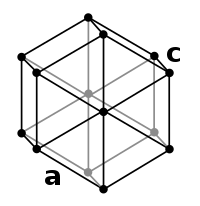
Photo from wikipedia
Zinc oxide is one of the well-known photocatalysts, the potential applications of which are of great importance in photoactivated gas sensing, water and air purification, photocatalytic synthesis, among others. However,… Click to show full abstract
Zinc oxide is one of the well-known photocatalysts, the potential applications of which are of great importance in photoactivated gas sensing, water and air purification, photocatalytic synthesis, among others. However, the photocatalytic performance of ZnO strongly depends on its morphology, composition of impurities, defect structure, and other parameters. In this paper, we present a route for the synthesis of highly active nanocrystalline ZnO using commercial ZnO micropowder and ammonium bicarbonate as starting precursors in aqueous solutions under mild conditions. As an intermediate product, hydrozincite is formed with a unique morphology of nanoplates with a thickness of about 14–15 nm, the thermal decomposition of which leads to the formation of uniform ZnO nanocrystals with an average size of 10–16 nm. The synthesized highly active ZnO powder has a mesoporous structure with a BET surface area of 79.5 ± 4.0 m2/g, an average pore size of 20 ± 2 nm, and a cumulative pore volume of 0.507 ± 0.051 cm3/g. The defect-related PL of the synthesized ZnO is represented by a broad band with a maximum at 575 nm. The crystal structure, Raman spectra, morphology, atomic charge state, and optical and photoluminescence properties of the synthesized compounds are also discussed. The photo-oxidation of acetone vapor over ZnO is studied by in situ mass spectrometry at room temperature and UV irradiation (λmax = 365 nm). The main products of the acetone photo-oxidation reaction, water and carbon dioxide, are detected by mass spectrometry, and the kinetics of their release under irradiation are studied. The effect of morphology and microstructure on the photo-oxidative activity of ZnO samples is demonstrated.
Journal Title: Micromachines
Year Published: 2023
Link to full text (if available)
Share on Social Media: Sign Up to like & get
recommendations!